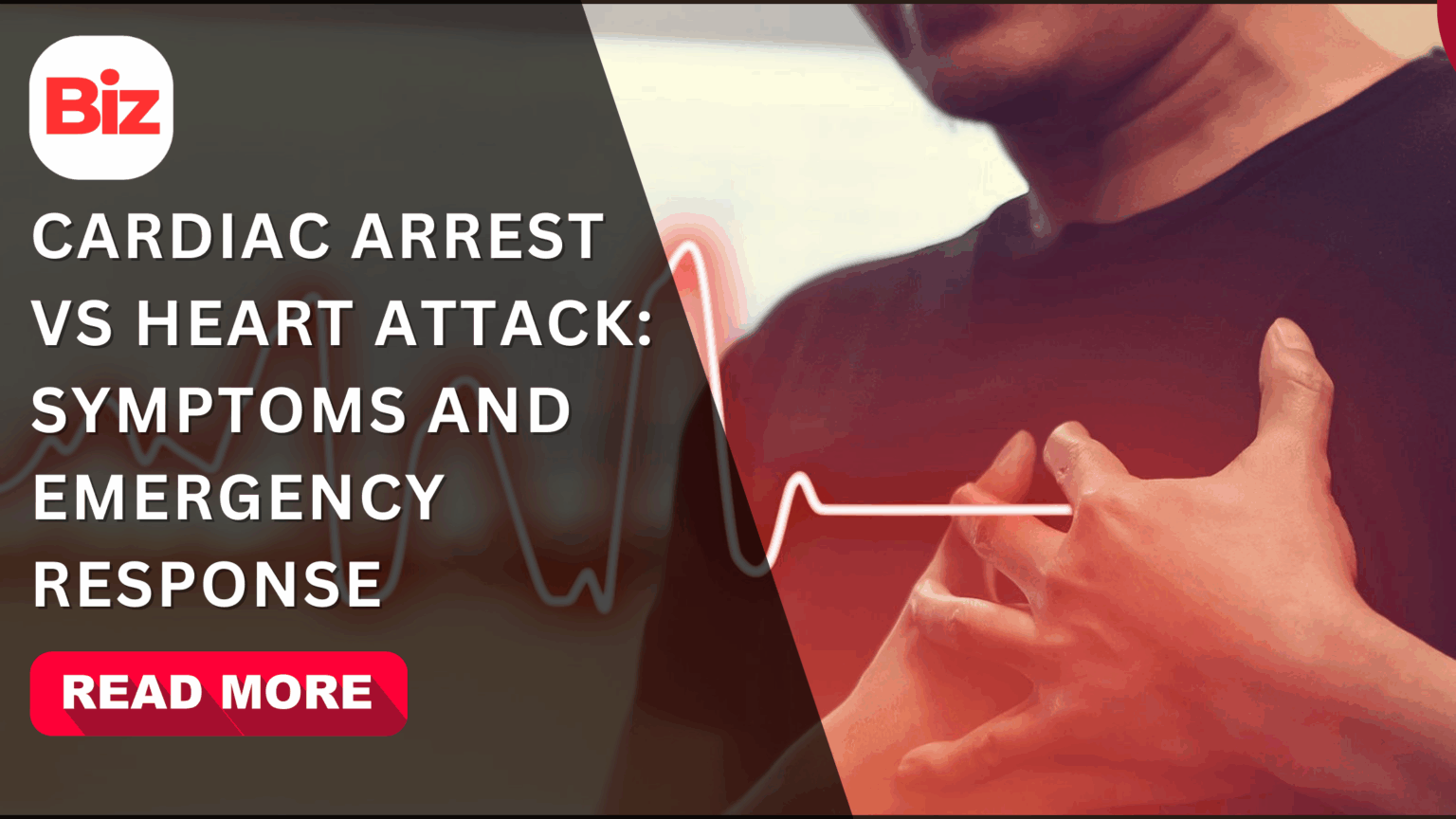- What Is a Heart Attack?
- Frequent Causes of a Heart Attack.
- Symptoms of a Heart Attack
- What Is Cardiac Arrest?
- Ordinary Causes of Cardiac Arrest.
- Symptoms of Cardiac Arrest
- Cardiac Arrest vs Heart Attack: The Major Differences.
- Emergency Response: Preparedness.
- Prevention: Keeping Your Heart Healthy.
- Why Awareness Matters
- Conclusion
There are two common terms used interchangeably when referring to heart health, however, in reality they represent two very different types of medical emergency cardiac arrest and heart attack. They are not equivalent as they are both serious, life-threatening disorders that need to be addressed urgently. Knowing the distinction between cardiac arrest vs heart attack is of utmost importance not only to the medical practitioners but also to the general population. Actually, the timely identification of the symptoms may be a life or a death situation.
What Is a Heart Attack?
Heart attack, or myocardial infarction, is a condition resulting when blood supply is interrupted to a section of the heart muscle. The formation of blood clot in the coronary arteries that supply the blood containing oxygen to the heart is usually the cause of this blockage.
Unless blood circulation is reinstated in time, the part of the heart muscle starts to degenerate. The more the blockage is left unattended, the more damage to the heart.
Frequent Causes of a Heart Attack.
- Coronary artery disease (CAD): It is the most widespread pathology, in which the fatty deposits (plaque) accumulate in the arteries.
- Blood clots: This may suddenly block a constricted artery.
- Coronary artery spasms: It is not common, but a risk factor.
Symptoms of a Heart Attack
- Pain or discomfort in the chest (which is commonly referred to as pressure, squeezing or fullness).
- Radiating to the arm, jaw, neck or back.
- Shortness of breath
- Nausea or vomiting
- Cold sweats
- Feeling dizzy or lightheaded.
It is necessary to mention that not every heart attack is accompanied by the typical chest pain. Conversely, the symptoms may be more elusive like fatigue, indigestion or shortness of breath in women.
What Is Cardiac Arrest?
A cardiac arrest is not such. It is an electrical issue as opposed to a circulation issue. The electric system of the heart fails, and the heart ceases its beating in cardiac arrest. The heart quivers or entire halts instead of pumping blood, so as to cut off the blood flow to the brain and important organs.
In a few seconds, the individual is unconscious and ceases to breathe normally. Cardiac arrest is virtually fatal unless emergency medical assistance is given.
Ordinary Causes of Cardiac Arrest.
- Ventricular fibrillation (VF): An irregular, atrial electrical heart rhythm.
- Arrhythmias: irregular heart rhythms, e.g. ventricular tachycardia.
- Severe heart attack: This can occasionally lead to cardiac arrest due to heart attack.
- Congenital heart disorders: Abnormal structures at birth.
- Cardiomyopathy: Thickening or enlargement of the heart muscle.
- Extreme shock or electrocution.
Symptoms of Cardiac Arrest
- Sudden collapse
- No pulse
- None or atypical breathing (gasping).
- Loss of consciousness
In most cases cardiac arrest is sudden and unpredictable as compared to a heart attack.
Cardiac Arrest vs Heart Attack: The Major Differences.
To draw the distinction, we will divide it up as follows:
Symptom Heart Attack Cardiac Arrest.
Cause Blocked blood supply to heart muscle Electrical defect in heart rhythm.
Onset Gradual, possibly accruing over hours or days Sudden, and usually unanticipated.
Symptoms Several pain in the chest, breathlessness, nausea, pain under the arm and discomfort Collapse, no pulse, no breathing
Consciousness Person tends to be on at the onset of the situation Person comes into unconsciousness in a few seconds
Emergency Response Call emergency services, administer aspirin where necessary, prepare to CPR where necessary Immediate CPR and defibrillation needed.
The correlation between heart attack and cardiac arrest.
They are not entirely independent conditions, although they are different. In other instances, cardiac arrest may start as a result of a heart attack. During heart attack when the heart muscle is deprived of oxygen, this can lead to harmful arrhythmias, and subsequently one can have cardiac arrest.
This is why it is so crucial to have a heart attack treated quickly not only to save heart muscle but to avoid development of cardiac arrest.
Emergency Response: Preparedness.
Being aware of what to do in both situations will save at least one life.
If You Suspect a Heart Attack:
Emergency services. Call now. Time is critical.
Make the individual relaxed and seated. Encourage them to rest.
Give aspirin (no allergy). This aids in thinning the blood and clotting down.
Monitor breathing and pulse. In case the individual faints, be ready to commence CPR.
In case You suspect cardiac arrest:
Dial emergency numbers.
Begin CPR right away. Hard and rapid in the mid chest- approximately 100-120 compressions/minute.
Insert an AED (Automated External Defibrillator) when possible. Take instructions of the device orally.
Proceed with CPR until the rescue. Each minute of no defibrillation reduction in survival chances is 7-10 percent.
Prevention: Keeping Your Heart Healthy.
Although both conditions are medical crises, they may be easily avoided through appropriate lifestyle habits and frequent visits.
Tips to Reduce Risk:
- Quit smoking. Smoking hurts the arteries and exposes one to the chances of both sudden cardiac arrest and heart attack.
- Maintain a healthy diet. Pay attention to fruits, vegetables, whole grains, and low-fat proteins.
- Exercise regularly. Those 150 minutes of moderate aerobic activity should be the goal at least once a week.
- Check blood pressure and cholesterol. Silent risk factors are high levels.
- Manage stress. Heart disease is caused by chronic stress.
- Know your family history. There are certain heart diseases which are inherited.
Why Awareness Matters
The meaning of cardiac arrest vs heart attack can be confused, even by the popular media. To give an example, when a star athlete goes on the ground, the news will be the wrong fact on the headlines stating that it has been a heart attack, when it was actually a cardiac arrest. This confusion may cause the bystanders to take long before responding appropriately.
The more people are sensitized about the difference, the more they will be able to prevent taking the initiative during emergencies. As an illustration, when someone is aware that chest pains are indicators of a heart attack, he or she might dial emergency services earlier. Awareness of the abrupt sudden cardiac arrest may produce instant CPR and AED- measures which have shown to save lives.
Conclusion
Knowledge of cardiac arrest vs heart attack is not merely all about medical jargon, but it is about saving lives. An attack on the heart is a circulation disorder that is caused by a blocked artery whereas cardiac arrest is an electrical disorder that causes the heart to cease beating.
They both need urgent emergency treatment, but the reactions are different. Complications can be avoided in the event of a heart attack, and this has to be done through early diagnosis and medication. In the case of cardiac arrest, the only solution is to revive life is by administering immediate CPR and defibrillation.








